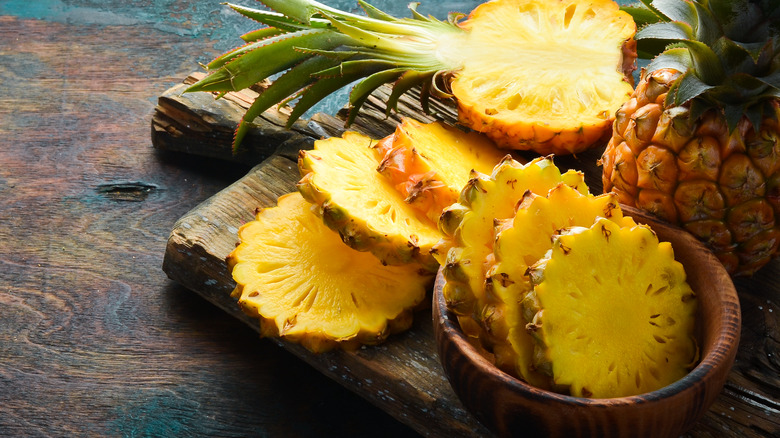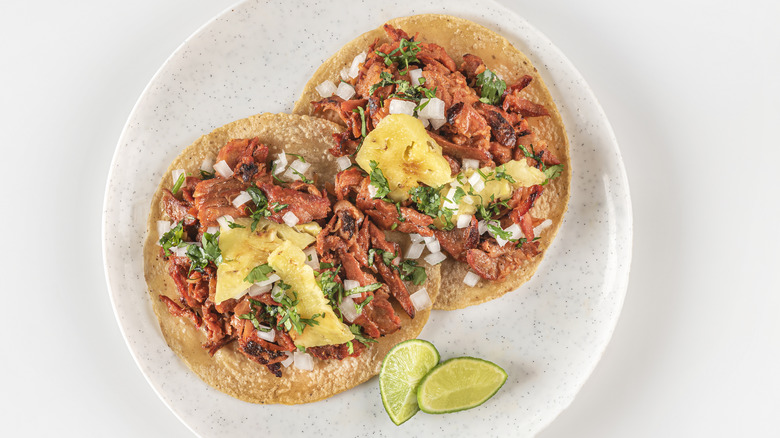Why Sage Works So Well With Pineapple Flavors
If you've ever had juicy pineapple salsa mixed with ribbons of chopped sage, you know the power of this seemingly unlikely flavor duo. If you haven't tried the combo, let us introduce you. Earthy and woodsy sage — when paired with pineapple (the whole fruit, the juice, or its flavors) — provides an herbaceous note that is bold enough to contrast the floral, fruity succulence of the fruit.
Though it's not super common to see the flavors together, it actually makes total sense that sage goes so well with pineapple. In culinary applications across global cuisines, sage is used in rich dishes like creamy Italian pasta sauces. It's also included in fatty sausages and chopped up and baked into hearty stuffings on Thanksgiving. Sage has a rather strong flavor — with its peppery, cooling, and sweet-savory qualities. So, the herb's boldness is ideal for adding depth to foods with lots of fat, or dishes with hearty vegetables like squash.
Similarly, pineapple's sweetness and tropical fruit notes are known to be strong and refreshing enough to balance rich foods, such as savory proteins like pork, chicken, and salmon. When paired together, sage is vibrant enough to work well with pineapple's comparatively brilliant flavors. Similar to pairing pineapple with cilantro, the herb's earthiness balances the sweetness while brightening and lifting the flavors of the pineapple and other ingredients within a dish.
Cooking applications for sage and pineapple
The beauty of the play between pineapple and sage is their versatility when paired together in both sweet and savory recipes. For cooking meat marinades, a bit of pineapple juice and chopped sage can complement and uplift the savory flavors of soy and teriyaki sauces. Since sage's woodsy qualities offset a pineapple's sweetness, the juice's impact on marinades or creamy coconut sauces will be more balanced and subtle.
You can skewer and grill pork or chicken with pineapple and bits of sage for a bold flavor combo that will work well with the strong smoky notes. If you please, add some chopped sage to top tacos al pastor, and the herb will brighten the seasoned shaved pork and refreshing pineapple chunks. Toss sage in to make an herbaceous pineapple salsa with diced jalapeño and tomatoes. It will add an earthy brightness and serve as a welcome change from cilantro or mint.
Sage and pineapple are also excellent in sweet culinary applications and baking. Muddle some sage with pineapple juice to create a range of complexly sweet and earthy cocktails or mocktails (think herbaceous mojitos or gin drinks). For an earthy boost to your sweet treats, chop up some sage to add it to a pineapple upside-down cake or to your favorite classic hummingbird cake recipe.
Further considerations when cooking with the herb
When pairing sage with pineapple, it helps to consider the seasonality of the herb. While sage is typically available in grocery stores throughout the year — especially over the holiday season for cooking with poultry and stuffing — it blooms beautifully in gardens throughout the summer months. Garden sage is a perennial shrub, which actually belongs to the same plant family as mint. So, for a twist on your recipes, you can use the herb in summery, bright applications where you'd use mint. Its flavor impact is more bold, woodsy, and earthy; and less cooling.
It's also important to note that sage's strong flavor can be softened or balanced by frying or cooking it. Of course, you can still add sage to fresh simple salads with pineapple, but you might consider frying the sage first in butter (or brown butter for extra nuttiness). Or, add chopped sage on top of homemade pineapple pizza before baking it, then let the cheesy, fatty goodness meld all the flavors together. However you choose to pair sage and pineapple — whether it's savory or sweet — the vivid flavors will stand out and balance each other beautifully.


